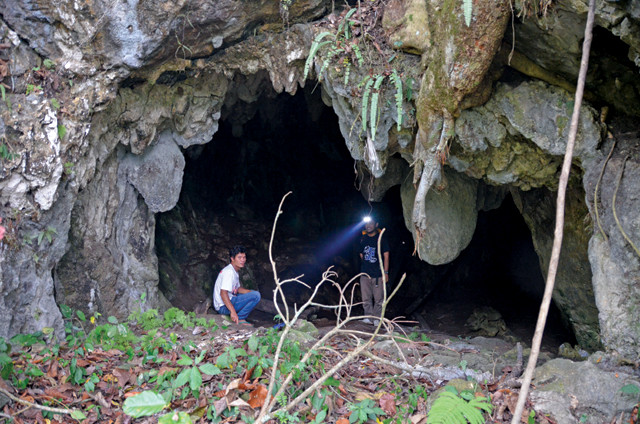
by Sarah Derouin Thursday, December 14, 2017

New research at Lida Ajer Cave in Sumatra, combined with data from human teeth found there in the 1880s, suggests humans were in Indonesia roughly 20,000 years earlier than previously thought. Credit: Julien Louys.
Modern humans began journeying out of Africa by at least 75,000 years ago, eventually expanding across the planet. Evidence of these early human travels, including fossils and artifacts, is typically spotty and difficult to find. But one such discovery more than a century ago has shed new light on the appearance of humans in Southeast Asia.
In the late 1880s, Dutch scientist Eugène Dubois excavated the Lida Ajer Cave in Sumatra, Indonesia. There, he found two teeth that looked to be from an early human, based on their size and shape. But at the time, the age of the teeth and the sediment they were found in was unknown.
One hundred twenty years later, a team of scientists set out to revisit Lida Ajer Cave. “The hardest part was trying to find the cave site again,” said Kira Westaway of Macquarie University in Australia, who led the effort, in a press release. “We only had a sketch of the cave and a rough map from a copy of Dubois’ original field notebook.” She and the team found the cave and collected samples of the sediment in which the teeth had been found to constrain their age.
Using modern luminescence and radiometric dating techniques on sediments and speleothems from the cave, the team found that the deposits dated to between 73,000 and 63,000 years ago. This suggests that humans had made their way to the region roughly 20,000 years earlier than indicated by the oldest previously-known skeletal records, Westaway and her colleagues reported in Nature. “We can now say with some confidence that modern humans had reached the island of Sumatra before 65,000 years ago,” Westaway said.
The team also noted that evidence found at Lida Ajer represents the earliest-known settling of modern humans in a rainforest, a relatively challenging environment in which to thrive that would have required sophisticated tools and hunting techniques.
© 2008-2021. All rights reserved. Any copying, redistribution or retransmission of any of the contents of this service without the expressed written permission of the American Geosciences Institute is expressly prohibited. Click here for all copyright requests.